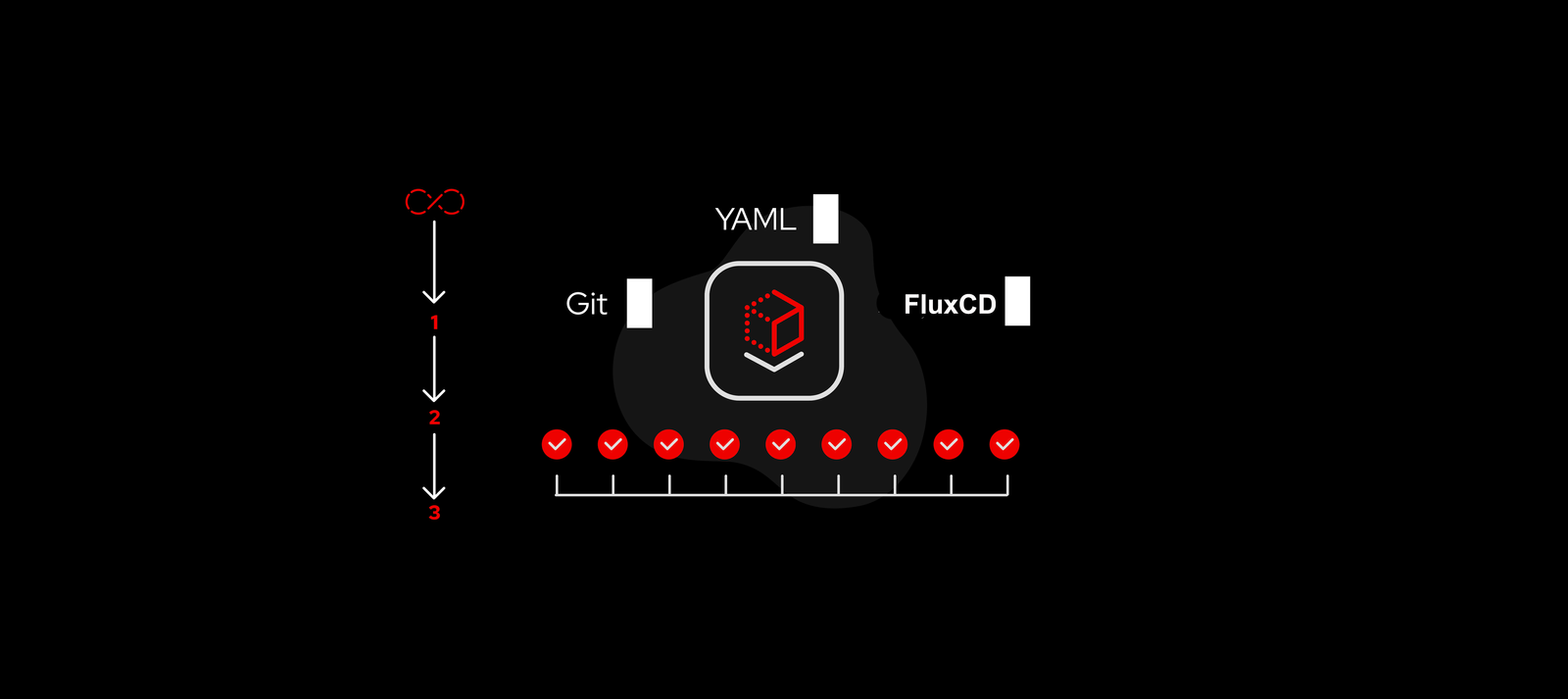Why GitOps is Essential for Modern Projects Today
In the world of continuous delivery and integration, GitOps has emerged as a game-changing methodology for managing and deploying applications. By leveraging the power of Git and Kubernetes, GitOps streamlines operations, reduces human error, and ensures greater consistency in deploying infrastructure and applications. In this article, we will explore the core concepts of GitOps, including how it can be implemented with Kubernetes using FluxCD and Carpenters, as well as the processes of containerization, delivery to ECR, and deployment with Kubernetes.
We’ll also dive into how GitHub is a powerful choice for projects with monorepos and why it stands out compared to other solutions like Bitbucket. Let’s get started!
What is GitOps?
GitOps is a practice that utilizes Git repositories as the single source of truth for defining and managing both infrastructure and applications. With GitOps, operations tasks like deployment, configuration management, and infrastructure provisioning are handled using Git pull requests, which is a significant shift from traditional CI/CD pipelines.
At its core, GitOps relies on the concept of declarative infrastructure. Instead of writing imperative commands to set up servers or deploy applications, GitOps users write declarative configuration files in Git, which are then automatically applied to the running systems. These files define the desired state of the infrastructure, and any changes to them trigger automatic updates to the actual state.
Setting Up Kubernetes for GitOps
Kubernetes has become the go-to orchestration platform for modern applications, and for good reason. It automates the deployment, scaling, and management of containerized applications. When paired with GitOps, Kubernetes becomes even more powerful, as changes to application code, infrastructure, or configurations can be made directly from a Git repository.
Installing Kubernetes with FluxCD and Carpenters
To implement GitOps with Kubernetes, tools like FluxCD and Carpenters can help automate the process.
- FluxCD is a GitOps operator for Kubernetes that continuously monitors your Git repositories and synchronizes them with your Kubernetes clusters. It works by pulling configuration changes from a Git repository and automatically applying them to the Kubernetes cluster. This means you can easily deploy and manage your applications using a Git workflow.Setting up FluxCD involves installing it on your Kubernetes cluster and linking it to your Git repository. The configuration files for your applications (including Kubernetes manifests, Helm charts, and other resources) are stored in a Git repository. FluxCD constantly polls the repository for updates and applies those changes to your cluster when they occur.
- Carpenters is a powerful tool for managing resources in Kubernetes clusters. It helps automate the provisioning and scaling of compute resources based on the workloads defined in your Git repository. When coupled with FluxCD, it ensures that your clusters are running the required resources to meet the demand of your applications, adjusting them automatically as the desired state changes in your Git repository.
Together, FluxCD and Carpenters create a seamless environment where Git is the single source of truth for both applications and infrastructure.
The GitOps Pipeline: Containerization, Delivery, and Deployment
One of the most powerful aspects of GitOps is the ability to automate the entire process, from code changes to deployment. Let’s break down how this works in practice.
Step 1: Building the Container
Every modern application today is built using containerized environments. Containerization allows developers to bundle their applications along with all their dependencies into isolated, reproducible environments. This is especially important when deploying applications at scale using Kubernetes.
Once the application is written and ready for deployment, it is first packaged into a container image. In a GitOps workflow, this process is typically handled by a CI pipeline. This is where tools like GitHub Actions or Bitbucket Pipelines come in. For the sake of simplicity, let’s focus on GitHub Actions as it’s a great fit for monorepo setups.
GitHub Actions offers native support for building container images using Docker or other containerization tools. Once the code is committed and pushed to the repository, GitHub Actions triggers the build process and creates a container image based on the Dockerfile. The container image is then pushed to a container registry like Amazon Elastic Container Registry (ECR).
Step 2: Pushing to ECR
Amazon ECR is a fully managed Docker container registry that makes it easy to store, manage, and deploy Docker container images. Once the container image is built, it needs to be uploaded to ECR for storage. This allows Kubernetes clusters to access the container image when deploying the application.
With GitOps, this process can also be automated. GitHub Actions or another CI tool can authenticate with AWS and push the newly built container image to an ECR repository. This can be achieved using AWS CLI commands within the CI pipeline, ensuring the image is available to Kubernetes when needed.
Step 3: Deploying with Kubernetes
Now that the container image is stored in ECR, the final step in the GitOps pipeline is deploying the application using Kubernetes. The desired configuration, including the Kubernetes manifests, is stored in a Git repository and automatically applied by FluxCD. These manifests contain details like which container image to use, the number of replicas, and any environment-specific settings.
FluxCD constantly monitors the Git repository for any changes to the Kubernetes manifests and will automatically apply them to the Kubernetes cluster. If any changes are detected, such as a new container image version, FluxCD will ensure that the Kubernetes cluster is updated with the new configuration.
This automated workflow removes the need for manual intervention in the deployment process, making it faster and less error-prone.
Why GitHub is Ideal for Monorepo Projects
Now, let’s dive into why GitHub is particularly well-suited for GitOps in monorepo setups.
A monorepo (short for “mono repository”) is a version control strategy where all of a project’s code (across multiple services, applications, or components) is stored in a single repository. Managing a monorepo can present challenges, especially when there are changes across different parts of the project.
In a typical GitOps pipeline, if there are changes in the repository, the entire pipeline is triggered. However, this is not ideal for monorepos, as there could be changes in multiple applications or services, but only some of them need to be redeployed.
This is where GitHub shines. GitHub Actions allows users to configure workflows that run conditionally, depending on which paths (folders or files) were changed in the commit. For example, if only one service is modified, only the pipeline for that service will run, saving time and resources.
In contrast, Bitbucket Pipelines requires additional manual configuration to achieve the same effect, which can add complexity. For monorepos, this makes GitHub a more convenient and powerful choice.
Why Bitbucket Pipelines Fall Short for Monorepos
While Bitbucket Pipelines supports CI/CD, it doesn’t provide the same level of flexibility when working with monorepos. In Bitbucket, you would need to manually configure pipelines to detect changes in specific parts of the repository and trigger the corresponding pipeline. This can become a cumbersome and error-prone process, especially as the size of the project grows.
For example, in a monorepo with multiple services or applications, a single commit might affect multiple services. While GitHub can automatically detect which parts of the codebase have changed and trigger the appropriate workflows, Bitbucket requires more manual intervention. This adds complexity and can lead to more mistakes in larger projects.
Conclusion
GitOps is a transformative methodology that simplifies application deployment and management by using Git repositories as the source of truth for both applications and infrastructure. By combining GitOps with Kubernetes, FluxCD, and tools like Carpenters, you can create a fully automated pipeline that builds, delivers, and deploys applications with minimal manual intervention.
For monorepo projects, GitHub is the ideal platform, offering built-in support for conditional pipeline execution based on modified paths. This flexibility ensures that only the affected services are redeployed, saving time and resources. In contrast, Bitbucket Pipelines doesn’t provide the same level of ease in managing monorepos, making GitHub a more suitable choice for GitOps.
By adopting GitOps and choosing the right tools like GitHub Actions, Kubernetes, and FluxCD, you can streamline your CI/CD pipelines, reduce human error, and ensure greater consistency in your deployments. GitOps is truly the future of modern software development and operations.



